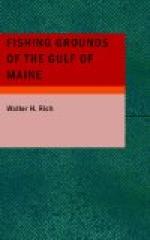In general this curve lies at a distance of about 16 miles from the coast line, but in many instances it approaches much neared to the mainland. From this 50-fathom depth the soundings decrease very gradually to the 20 and 10 fathom marks.
These latter soundings are often held far in toward the coast line, even carrying the deep water well into the river mouths, so that in deeply indented hays, in long inlets running far into land, in the river mouths, the deep water behind the rocky headlands, or in the lee of the thousands of surf-washed islands that line the coast, are found innumerable safe anchorages within easy run of the fishing grounds, where the fleets may take shelter from a sudden blow or await the arrival of a “fish day,” when conditions may permit “making a set” under the hardships of winter fishing.
If the marine features of this region are radically different from those of other coastal bodies of the eastern United States, so, too, the shore land, battered as it has been by sea and storm or worn by glacial action or Arctic currents, is no less remarkable.
No other section of the eastern United States has a similar coast, so serrated, indented, and rugged, as has this shore line of the Gulf of Maine. Here the battering by the forces of nature has resulted in making thousands of safe harbors and havens for the navigator. All along shore are strewn hundreds of islands, a characteristic feature of the region and one noted with wonder by every early explorer. [6] These islands, if near the land, are beautiful and smiling; if in the open sea, of rugged grandeur; and mainland and island alike are inhabited by a numerous and hardy race of fisher folk.
The tides within the Gulf of Maine have a very great rise and fall as compared with other waters in this region. At the south of Cape Cod tides are seldom over 4 feet in their range, but beginning at once at the north of Cape Cod with a rise of from 7 to 10 feet these increase quite constantly as they go eastward reaching about 28 feet in the neighborhood of Passamaquoddy Bay, to touch their highest point in the Bay of Fundy, where in many places is a rise and fall of 50 feet, and in some few places tides of 70 feet are reported. These Fundy tides probably are the greatest in the world.
This great ebb and flow of water serves to aid shipbuilding and the launching of vessels as well as to carry the deep water far up into the inlets of the coast and into the mouths of the rivers, making these navigable for crafts of considerable size well into the land or up to the lowest falls of the streams.
The climate here is one of extremes, and, lying as it does between 42 deg. and 45 deg. north latitude, the region may be said to be cold. Apparently the waters of the Gulf of Maine are not affected by any stray current from the Gulf Stream, which passes at a considerable distance from its mouth, thus doing little to temper the cold of this area either on land or at sea. Whether these waters are cooled further by any flow from the Labrador Current may be questioned.




